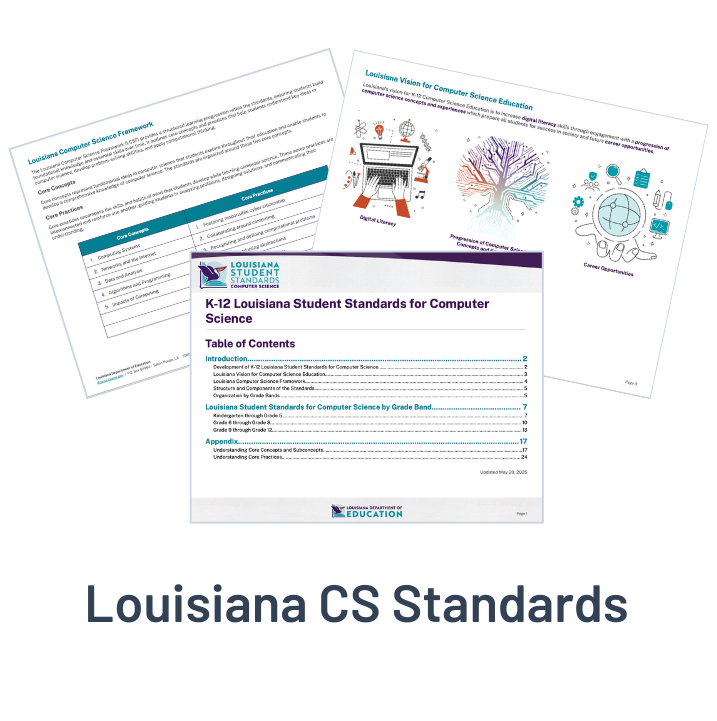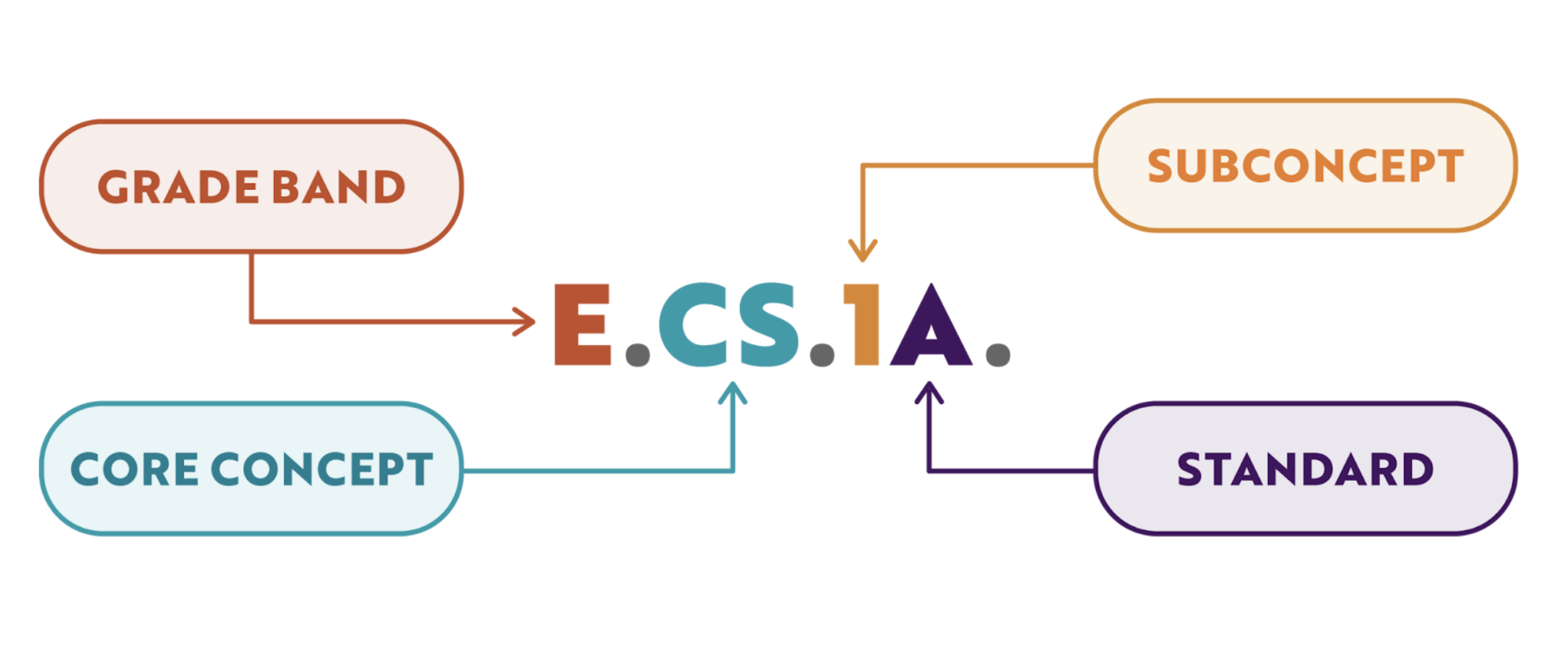Teach Louisiana K-8 Computer Science with ease. Equip your classrooms with ready-to-teach lessons aligned to the BESE-adopted Louisiana Computer Science Standards (2024). Code4Kids makes it simple to deliver engaging, standards-aligned computer science and coding instruction with confidence.
Explore our complete guide to Louisiana’s 2024 K–12 Computer Science Standards, designed for teachers and district leaders. Learn the history behind the Louisiana Department of Education’s rollout, gain a clear breakdown of the standards, and find practical steps to implement a curriculum that meets state requirements and builds digital literacy for every student.
Already up to speed? Access our Louisiana CS Curriculum here
In 2022, the Louisiana Legislature passed Act 541 – the Computer Science Education Act, establishing the Computer Science Education Advisory Commission (CSEAC) to create a statewide plan for K-12 computer science education. This was Louisiana’s first step toward a comprehensive computer science curriculum that prepares students for a technology-driven economy.
After statewide collaboration with educators, school leaders, industry partners, and parents, the Louisiana Department of Education (LDOE) completed the first K–12 Louisiana Student Standards for Computer Science in 2024. These standards ensure that every student, from kindergarten through high school, gains digital literacy skills, problem-solving abilities, and equitable access to computer science education.
In October 2024, the State Board of Elementary and Secondary Education (BESE) officially adopted the standards. Full statewide implementation begins in the 2025–2026 school year, supported by LDOE training, resources, and professional development for educators. Download K-12 Louisiana Student Standards for Computer Science PDF Document here
Louisiana’s K–12 Computer Science Standards are designed to ensure every student - regardless of race, gender, or geography - can access high-quality computer science education. Since the passage of Act 541, the state has more than doubled the number of high schools offering foundational CS courses, with participation now reflecting the overall student population and some of the nation’s highest female participation rates.
While challenges remain, such as teacher shortages and resource gaps in some schools, the Louisiana Department of Education and its partners are addressing these through professional development, funding initiatives, and statewide support networks. The goal is clear: close digital divides, expand opportunities in every parish, and prepare all students for the high-demand, high-wage careers of the future.
At Code4Kids, we contribute to closing these gaps by offering personalized and group professional development, unlimited coaching, ongoing check-ins, and one-to-one support. This ensures schools can deliver high-quality computer science instruction and expand opportunities for all students.

The Louisiana K–12 Computer Science Framework (LCSF) provides schools and districts across Louisiana with a clear, standards-aligned pathway to implement high-quality computer science education from kindergarten through grade 12. This statewide framework ensures students progressively build foundational computer science knowledge and essential digital skills, preparing them for college, careers, and active participation in a technology-driven society.
The framework is organized into five Core Concepts (what students learn) and seven Core Practices (how students work and think). Each Core Concept contains sub-concepts that define specific areas of focus. This structure helps educators build digital literacy and future‑ready skills in every classroom.
%20(1).png)
The framework is organized into five Core Concepts (what students learn) and seven Core Practices (how students work and think).
Each Core Concept contains sub-concepts that define specific areas of focus. This structure helps educators build digital literacy and future‑ready skills in every classroom.
The Five Core Concepts Include:
The Seven Core Practices Include:
Building on the Core Concepts and Core Practices outlined above, the Louisiana K–12 Computer Science Standards are organized into three grade bands: Elementary (K–5), Middle (6–8), and High School (9–12). This progression ensures that students first encounter computer science through accessible, age-appropriate experiences, then revisit and expand on those ideas with increasing complexity as they move through school.
Elementary students explore computer science through hands-on activities, developing vocabulary, basic problem-solving skills, and an understanding of digital citizenship.
Middle school students apply these foundations to more structured challenges, including programming functional solutions, investigating networks and cybersecurity, and analysing data in depth.
High school students engage with advanced concepts, such as designing and implementing complex programs, analysing algorithms, studying data structures, and evaluating the societal impacts of technology.
This grade-banded approach ensures that each Core Concept is revisited multiple times, allowing students to deepen their understanding and skills while preparing for further study, career pathways, and responsible participation in a digital world.

This table shows how the Hardware and Software sub-concept (301) progresses across grade bands, emphasizing both selection and analysis of hardware and software interactions.

For each grade, the curriculum outlines clear complexity statements that scaffold student understanding of computing hardware. Looking at this example of Computing Systems Hardware:
The coding system for the computer science standards is designed to be clear and systematic, allowing easy identification of the grade band, core concept, subconcept, and specific standard. Below, you’ll find an image of the Louisiana Computer Science standards that outlines an example from Early Elementary (K–2), with each part broken down for clarity.
You can read the complete document from the Louisiana Department of Education here

In the image you'll see:
In Louisiana, effective K–8 Computer Science instruction is essential for preparing students for the future. This is where Code4Kids makes it simple for teachers, even those with no prior CS experience. Our curriculum is fully aligned to the Louisiana K–12 Computer Science Standards, giving educators the support, resources, and confidence they need to succeed.
The first step is choosing the right starting point for your learners. Successful CS implementation often rolls out over two to three years, and no one knows your students better than you. That’s why Code4Kids offers a flexible, structured curriculum that adapts to your school’s context, ensuring steady progression at a pace that works for your classrooms.
Focus on sparking curiosity and introducing the building blocks of computer science through playful, age-appropriate activities. Simply begin at the grade that best matches your students’ needs - courses are flexible, with no strict prerequisites, and grade-level suggestions are a recommended starting point only.

In Upper Elementary, we emphasise applying foundational skills to create programs, explore data, and develop problem-solving strategies. Build on earlier foundations or start fresh at the grade level that suits your learners, progressing at a pace that works for your school.

Concentrate on real-world applications of computer science, combining programming, data analysis, and cybersecurity in collaborative projects. Begin where your students are, whether continuing from earlier courses or starting new - the sequence is adaptable to support steady growth in skills and confidence.


At Code4Kids, we believe every district has its own story — shaped by its schools, staffing models, community priorities, and the opportunities and challenges unique to its region. The Louisiana K–12 Computer Science Standards, adopted by BESE in 2024, set a clear vision for equitable access, digital literacy, and future-ready skills. But meeting those goals takes more than a one-size-fits-all approach.
Built for Louisiana’s Standards
Our curriculum is built for Louisiana’s context. It goes beyond simply aligning to the five Core Concepts, seven Core Practices, and their related sub-concepts — it creates a cohesive pathway from Lower Elementary (K–2) through Middle School (6–8) that adapts to your district’s starting point.
Custom Pathways for Every District
Before any rollout, we work alongside district leaders and teachers to understand your current CS offerings, available resources, and community goals. Whether your priority is expanding access in rural schools, addressing teacher shortages, or building on existing STEM initiatives, we co-create an implementation plan that fits your schedules, staffing, and budget.
Continuous Support for Lasting Success
Our support is continuous. Onboarding includes personalized and group training, followed by unlimited coaching, regular check-ins, and fast response when needs change. Quarterly reports translate usage and student progress into actionable insights — helping you track growth, address gaps, and celebrate success.
We’re not just a vendor. We’re a long-term partner committed to helping every Louisiana student thrive in computer science, from their first block of code to the complex projects they create in middle school.
.png)
Every district is different, so our first step is a collaborative conversation to understand your goals, challenges, and current Computer Science programs.
During this process, we will develop:
Once we’re on board, we kick off your first phase of implementation - smoothly and strategically.
We provide regular updates that celebrate progress and impact. This includes the following:
Technology moves fast. We help your district stay ahead. We achieve this by: